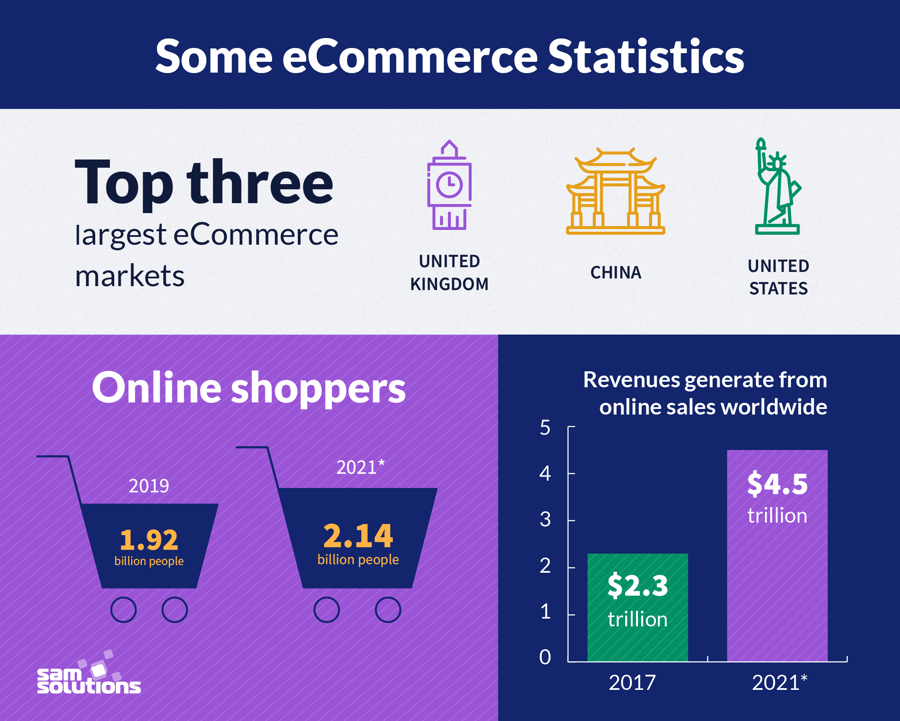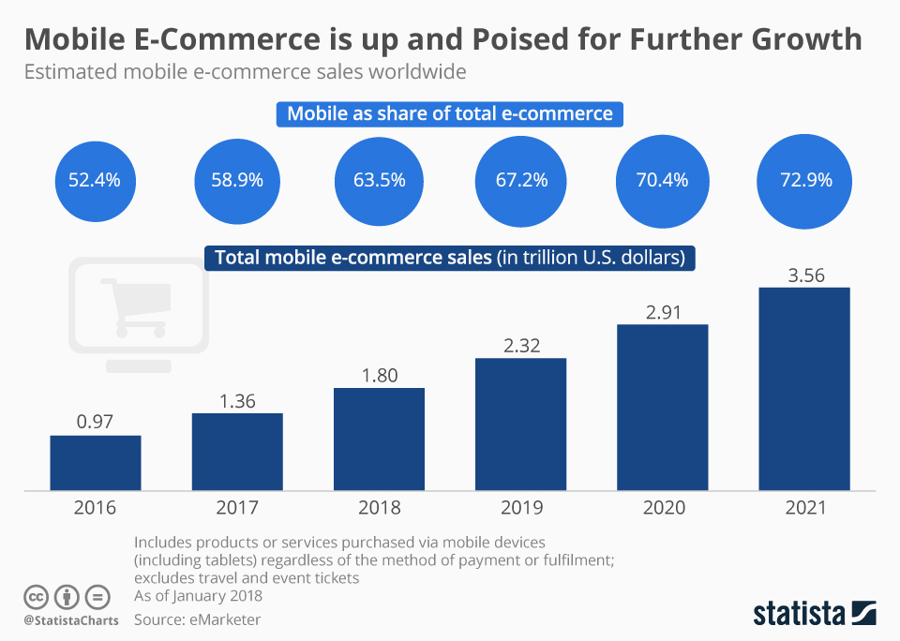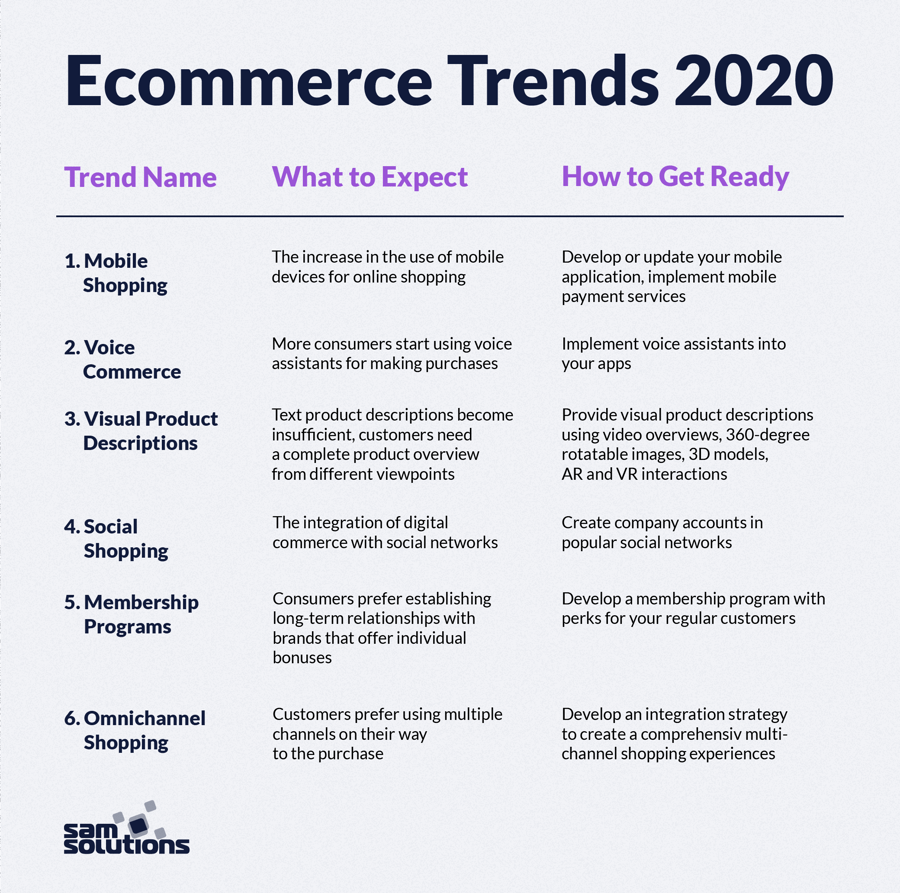
Ever-growing and ever-changing — these are two characteristics that best describe the current state of eCommerce. Online shopping attracts more and more users, seamlessly merging with their daily routines. That is why it’s extremely important to deliver relevant customer experiences and make their digital journey as flawless as possible.
How can you find the necessary knowledge to build a successful eCommerce website and increase the income of your online store? A good way is to constantly monitor industry trends and put them into practice.
In this article, we’ve compiled a list of eCommerce trends that will define the industry in 2020 — so that you can be on the front line in the coming year.
Some eCommerce Statistics
To create a perfect eCommerce solution that best serves your online business, you’ll need to be aware of both the current industry landscape and the projected future.
- 92 billion people (about 25% of the world’s population) are predicted to be online shoppers in 2019. By 2021, the number of digital buyers is expected to reach 2.14 billion people.
- The top three largest eCommerce markets are the US, China and the United Kingdom.
- Revenues generated from online sales were approximately $2.3 trillion in 2017. This number is expected to reach $4.5 trillion by 2021.

Top eCommerce Trends to Watch Out for in 2020
Why is it important to discuss the main trends that influence the industry? There are two great benefits:
- When you reveal factors that stimulate customers to buy online, you can learn about your customers, better understanding their preferences, expectations and behavior.
- Consequently, when you know what your customers want, you can create new business opportunities and make improvements.
Let’s look to the future.
1) Mobile Shopping
An overall tendency to use mobile devices rather than desktops or laptops penetrates all business domains – especially eCommerce. Such is the psychology of modern consumers: they desire immediate satisfaction of their demands and wishes. This means that they want to have access to products and services — be it listening to music or purchasing goods — right at their fingertips.
No limitations means happier customers and increased conversion rates. And mobile devices are definitely the most convenient tools for providing the freedom of researching products and buying them from any location at any time.
Thus, the main eCommerce trend for the coming year is an increase in the use of mobile devices for online shopping. Statista has been tracking the constant growth of mobile sales every year since 2016 and estimates that, by 2021, more than 72% of total eCommerce sales worldwide will be performed via mobile devices.

Active development of mobile payment services is the consequence of this trend because quick cashless transactions have become a necessity. The most popular services are PayPal, Apple Pay and Visa Checkout.
Online stores are offering an average of three payment methods at checkout, including digital wallets. Think about implementing mobile-optimized payment options into your business app — it’s a must now.
If you haven’t developed a mobile solution for your online store yet, it’s time to get started. If your online store has its own app, but it doesn’t work well, you can improve it in accordance with user desires and needs.
2) Voice Commerce
Due to huge investments into the development of artificial intelligence and machine learning, voice-powered technology is on the rise now. Online selling is the very domain that started actively integrating this technology.
Searching products and making purchases by voice is becoming more popular because of the growing accuracy and convenience of this technology. Again, the driving force behind this trend is the desire of consumers to get the best result with the least effort.
Amazon was a pioneer in the field of voice commerce when they enabled voice purchasing using Alexa. Today, 13% of families in the US have smart speakers, and 36% of those families use them for regular purchasing. Meanwhile, 62% of smart speaker owners used them at least once for buying goods. These figures prove that voice commerce is accelerating and deserves the attention of online business owners.
3) Visual Product Descriptions
The main disadvantage of buying online is the users’ inability to have physical contact with items they want to purchase.
Text product descriptions and photos are not enough anymore. It’s a fact that most consumers prefer watching product videos than reading text descriptions when they’re researching. Buyers want to look at products from different angles to dispel doubts concerning the quality of goods and press the “Buy” button with confidence.
The time has come for retailers to provide as complete a product description as possible. They should consider offering:
- Video overviews
- 360-degree rotatable images
- 3D models
- Augmented and virtual reality interactions
Sellers should also focus on interactive product descriptions that will explain all the relevant information and make customers feel like they have a better picture of what it looks like in real life.
4) Social Shopping
One more major trend is the integration of eCommerce with social media networks. This step is reasonable because of the mind-blowing popularity of social media as a whole. More brands recognize the potential of such popularity and have begun looking at social channels as powerful advertising platforms with a huge pool of potential clients. So why not make use of it?
The importance of social media as it pertains to eCommerce comes from a range of social networking aspects:
- Groups and communities
- Discussions and testimonials
- Likes and dislikes
- AI-based recommendations
- Targeted advertisements
As of 2019, there are 3.2 billion social media users worldwide, and this number is growing. 54% percent of customers use social networks to research products looking for recommendations and reviews.
Basically, people may not even be looking for products as they scroll through their news feeds. But when they run into some attractive offering with hundreds of likes while browsing, it’s hard to resist making an impulse purchase.
The obligatory condition for client retention is the simplicity of the buying process. For this reason, major social media players such as Instagram, Facebook, Twitter, Pinterest, and YouTube added their own “Buy” buttons. They also support product pages and try to build their own eCommerce platforms or integration solutions.
Put in the effort to create your company’s accounts on popular social media channels in order to increase sales in 2020.
5) Membership Programs
This model of eCommerce business implies the creation of communities or membership programs that offer certain benefits to regular customers depending on their activity.
Types of possible benefits include:
- Personal discounts
- Free delivery
- Priority access to novelties
- Access to limited edition products
- Member-only offerings
- Invitations to special brand events
Why does this work? Customers like personalization and the feeling of uniqueness, especially in the digital age when we rarely communicate face-to-face. They prefer to establish long-term relationships with brands that offer quality products with attractive bonuses. Thus, a membership program is an effective tool for gaining customer loyalty.
One more option for making clients happier is subscription-based shopping, which mostly suits people who are time-constrained or just hate regular shopping.
It works like this:
- A customer chooses goods that should be delivered once a week/month (e.g. food, cleaning materials, items of clothing such as socks and lingerie).
- A retailer automatically repeats purchases at a specific given time and delivers it to the customer's home or office.
The scheme is quite simple, but very efficient for both parties as it’s a great time-saver. If your company offers goods or services that people need weekly or monthly, a subscription service is right for you.
6) Omnichannel Shopping
Customers appreciate freedom of choice during their shopping journey — that’s why multiple selling and purchasing channels are becoming a must for retail companies. Companies should develop an integration strategy to create a comprehensive multi-channel shopping experience and provide various possibilities to arrive at the purchase, for instance:
- Research online, buy in-store
- Research online, buy online, pick up in-store
- Research and buy in-store, choose home delivery (a necessity for bulk goods)
- Research via an app, buy via a website (or vice versa), choose home delivery
- Pay online, by credit cards or by cash
It’s obvious that the eCommerce business can’t be strictly divided into online-only or offline-only anymore. To keep pace with competition, companies should integrate the following components into a single system synchronizing online and offline data:
- A website
- A mobile application
- A brick-and-mortar/physical store
- A self-pickup point
- Various delivery options
- Various payment options
It’s been proven that the more channels shoppers use, the higher the average order value. Every touchpoint is important!
Guide for eCommerce Businesses for 2020
To recap, let’s go through the most important trends that we’ve covered:
- Develop a mobile application or update an existing one.
- Implement mobile payment services into your application.
- Implement voice assistants into your application.
- Provide visual product descriptions instead of written ones.
- Make use of social networks and targeted marketing.
- Develop a membership program with perks for your regular customers.
- Use multiple channels for selling your products and services.
Client-Centered Approaches Are the Future
You are not obliged to implement all the new features that current eCommerce trends suggest in your business processes. But if you analyze them, you can understand the right direction to move forward in.
Two words — client-orientation and personalization — unify the trends described above and provide the core message for digital traders: the client is the main player in digital trading systems today. If you don’t satisfy the needs and desires of your shoppers, you will lose this game.
Get to know your customers by researching their personal data, browsing history and previous purchases, and you’ll be able to deliver only relevant content to them and make their shopping process seamless and attractive.
Drive your business to new heights using the potential of a modern eCommerce business.






Leave a reply or comment below